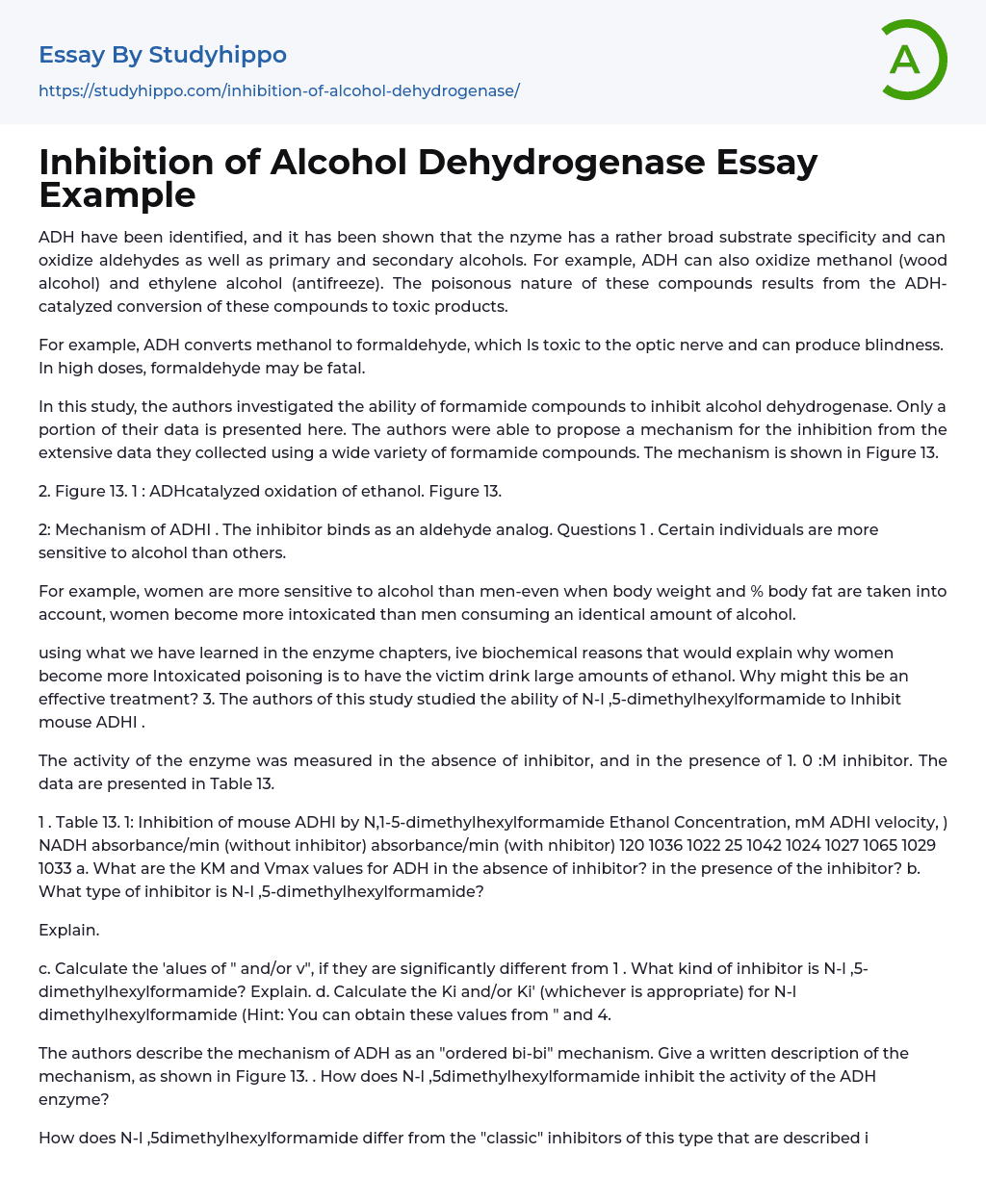ADH have been identified, and it has been shown that the nzyme has a rather broad substrate specificity and can oxidize aldehydes as well as primary and secondary alcohols. For example, ADH can also oxidize methanol (wood alcohol) and ethylene alcohol (antifreeze). The poisonous nature of these compounds results from the ADH-catalyzed conversion of these compounds to toxic products.
For example, ADH converts methanol to formaldehyde, which Is toxic to the optic nerve and can produce blindness. In high doses, formaldehyde may be fatal.
In this study, the authors investigated the ability of formamide compounds to inhibit alcohol dehydrogenase. Only a portion of their data is presented here. The authors were able to propose a mechanism for the inhibition from the extensive data they collected using a wide variety of formamide compounds. The mech
...anism is shown in Figure 13.
2. Figure 13. 1 : ADHcatalyzed oxidation of ethanol. Figure 13.
2: Mechanism of ADHI . The inhibitor binds as an aldehyde analog. Questions 1 . Certain individuals are more sensitive to alcohol than others.
For example, women are more sensitive to alcohol than men-even when body weight and % body fat are taken into account, women become more intoxicated than men consuming an identical amount of alcohol.
using what we have learned in the enzyme chapters, ive biochemical reasons that would explain why women become more Intoxicated poisoning is to have the victim drink large amounts of ethanol. Why might this be an effective treatment? 3. The authors of this study studied the ability of N-l ,5-dimethylhexylformamide to Inhibit mouse ADHI .
The activity of the enzyme was measured in the absence of inhibitor,
and in the presence of 1. 0 :M inhibitor. The data are presented in Table 13.
1 . Table 13. 1: Inhibition of mouse ADHI by N,1-5-dimethylhexylformamide Ethanol Concentration, mM ADHI velocity, ) NADH absorbance/min (without inhibitor) absorbance/min (with nhibitor) 120 1036 1022 25 1042 1024 1027 1065 1029 1033 a. What are the KM and Vmax values for ADH in the absence of inhibitor? in the presence of the inhibitor? b. What type of inhibitor is N-l ,5-dimethylhexylformamide?
Explain.
c. Calculate the 'alues of " and/or v", if they are significantly different from 1 . What kind of inhibitor is N-l ,5-dimethylhexylformamide? Explain. d. Calculate the Ki and/or Ki' (whichever is appropriate) for N-l dimethylhexylformamide (Hint: You can obtain these values from " and 4.
The authors describe the mechanism of ADH as an "ordered bi-bi" mechanism. Give a written description of the mechanism, as shown in Figure 13. . How does N-l ,5dimethylhexylformamide inhibit the activity of the ADH enzyme?
How does N-l ,5dimethylhexylformamide differ from the "classic" inhibitors of this type that are described in our textbook? 5. The authors found that a class of compounds called pyrazoles were also inhibitors of ADH.
These inhibitors bind to the E-NAD+ complex. What kind of inhibitor are pyrazoles? Are these inhibitors the same or different as the formamides? 5. a. Would N-l ,5-dimethylhexylformamide be an effective alternative for the treatment of methanol and ethylene glycol poisoning, assuming that it is non-toxic self (and as an alternative to getting the patient drunk, as described.
- Adaptation essays
- Adventure essays
- Adversity essays
- Aging essays
- Alcohol essays
- Barbie Doll essays
- Beauty essays
- Care essays
- Carpe diem essays
- Change essays
- Chess essays
- Chicken essays
- Choices essays
- Contrast essays
- Crops essays
- Development essays
- Dream essays
- Evil essays
- Experience essays
- Family essays
- Farm essays
- Fire essays
- First Love essays
- Focus essays
- Greed essays
- Hero essays
- Holiday essays
- House essays
- Housing essays
- Humility essays
- Humor essays
- Hypocrisy essays
- Integrity essays
- Law of Life essays
- Life Changing Experience essays
- Life Experience essays
- Lifestyle essays
- Limitations essays
- Love Story essays
- Mother Tongue essays
- Motherhood essays
- My Neighborhood essays
- Myself essays
- Mystery essays
- Narcissism essays
- Never Give Up essays
- Nursing essays
- Object essays
- Opportunity essays
- Peel essays




